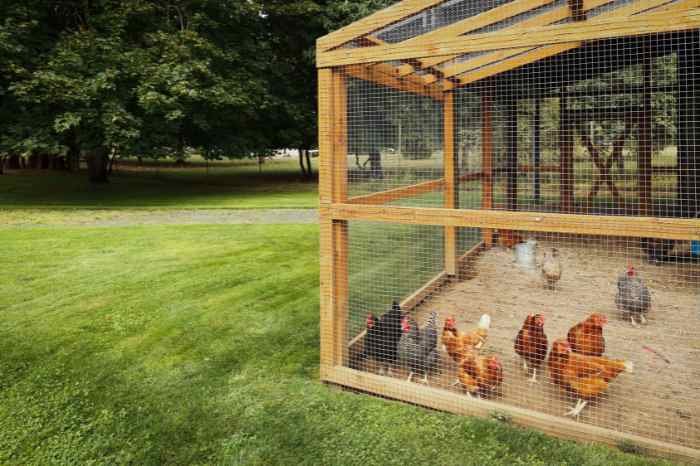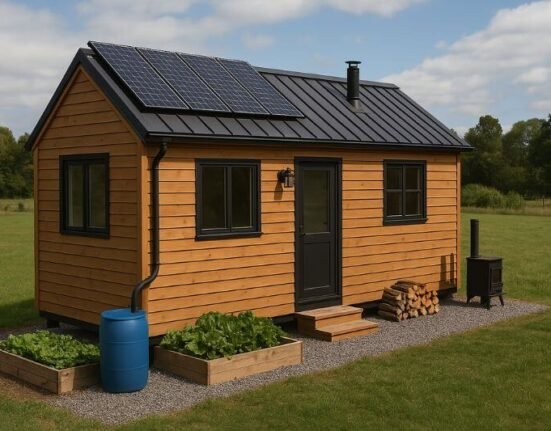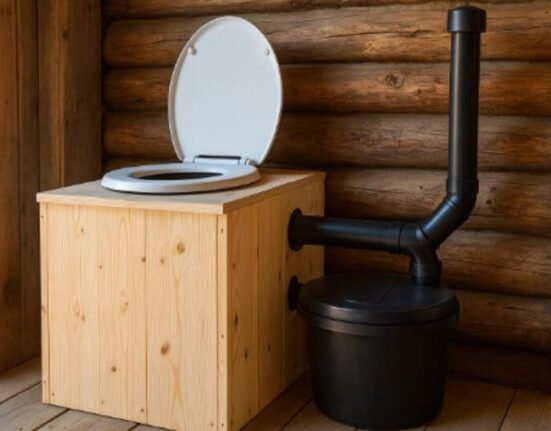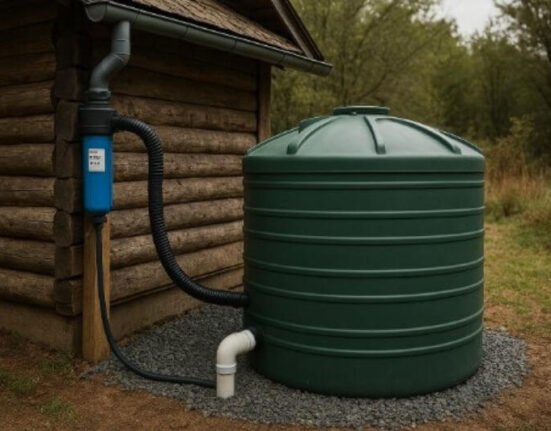Off-grid chicken farming isn’t just about raising birds — it’s about building a resilient protein system that thrives without electricity, feed stores, or grid dependence. In any long-term crisis or self-sufficiency plan, chickens offer a steady supply of eggs, compost, pest control, and even meat.
The beauty of it? Chickens are simple to manage, incredibly productive, and adapt well to almost any environment — making them the smartest first step toward food sovereignty and off-grid survival.
🧱 Part 1: Why Chickens Are the Ultimate Off-Grid Livestock
🥚 Multifunctional Animals = Maximum Resilience
Chickens are one of the most versatile animals you can raise in an off-grid setting. A small flock provides:
- Fresh eggs daily (6 hens = 30+ eggs/week)
- Meat on-demand (dual-purpose or broiler breeds)
- Fertilizer from nitrogen-rich droppings
- Insect control (especially ticks and flies)
- Weed clearing through scratching and grazing
- Compost acceleration in hot piles
💡 Bonus: Roosters add security (and alarm clock functionality) — and can protect the flock from small predators.
🔋 No Electricity Required: Truly Off-Grid Compatible
Unlike goats, pigs, or cows, chickens:
- Don’t require electric fencing
- Can live in simple coops made from salvaged wood
- Thrive with manual watering and feeding
- Are easy to handle and transport
“A chicken coop is easier to build than a compost toilet — and gives you breakfast every morning.” — Rural Survivalist Field Manual, 2022
🌍 Best Chicken Breeds for Off-Grid Environments
Choose hardy, dual-purpose breeds that tolerate variable climates, forage well, and lay consistently.
| Breed | Eggs/Year | Climate Tolerance | Notes |
|---|---|---|---|
| Rhode Island Red | 250–300 | Excellent (cold & hot) | Dual-purpose, very hardy |
| Plymouth Rock | 200–250 | Great in cold | Gentle, good foragers |
| Australorp | 250–300 | Good all-around | Quiet, high egg production |
| Orpington | 180–220 | Cold-hardy | Great for meat, docile temperament |
| Leghorn | 280–320 | Heat-tolerant | High-laying, but flighty and nervous |
✅ For true sustainability, aim for a dual-purpose flock: layers + meat birds.
🏡 How Many Chickens Do You Need?
This depends on your goals: eggs, meat, or both.
🧮 Basic Planning Table:
| Goal | Birds Needed |
|---|---|
| 1 dozen eggs/week | 3–4 hens |
| Family of 4 eggs + meat | 6–10 hens + 1–2 roosters |
| Breeding & barter | 10+ hens, multiple roosters |
🧠 Tip: Start small. A starter flock of 5 hens is manageable, quiet, and produces up to 1000+ eggs/year.
🛖 Coop Setup: Simple, Functional, and Predator-Proof
You don’t need a fancy coop — just a structure that offers:
- Protection from weather
- Security from predators
- Nesting space (1 box per 3–4 hens)
- Roosting bars
- Easy access for cleaning
Off-grid building materials:
- Pallets or reclaimed wood
- Metal sheeting or tarps
- Hardware cloth (stronger than chicken wire)
- Straw or shredded leaves for bedding
💡 Ventilation is critical — never seal the coop airtight.
🧼 Chicken Manure: Waste or Gold?
Chicken droppings are high in nitrogen, making them an excellent compost booster. However, raw manure is “hot” — it must be composted before use on plants.
- Collect bedding + droppings weekly
- Mix into your compost pile
- Let cure for 4–6 months
- Use in garden beds, fruit trees, or pasture rotation
“One chicken can produce enough compostable manure to fertilize a 100-square-foot garden every year.” — Homestead Soil Science Journal, 2021
🛠️ Part 2: Feeding, Watering, and Protecting Your Flock Off the Grid
🐥 Feeding Chickens Without Store-Bought Grain
In a true grid-down or remote survival scenario, chicken feed bags aren’t an option. Fortunately, chickens are natural foragers and omnivores — and with the right setup, you can grow or scavenge nearly 100% of their diet.
✅ Alternative Off-Grid Feeds:
- Kitchen scraps: veggies, rice, bread (no mold, no raw meat)
- Garden surplus: overripe tomatoes, greens, squash
- Compost insects: chickens will scratch and feed on grubs
- Black soldier fly larvae: can be farmed in bins for high protein
- Sunflower seeds or corn: grow a small patch for fall feed
- Sprouted grains: soak wheat, barley, or oats to multiply nutrients
- Pasture rotation: let chickens graze on clover, dandelions, insects
🛑 Avoid: raw potato peels, avocado pits, onion skins, and chocolate (toxic)
“Off-grid chickens are your clean-up crew — they convert scraps into protein, no feed store required.” — Sustainable Poultry Network
💧 Watering Without a Hose or Electric Pump
Chickens need about 0.5 liters of water per bird per day — more in hot climates or during egg-laying.
Off-grid watering solutions:
- Rainwater catchment → connect barrels to nipple drinkers
- Gravity-fed buckets with PVC pipes or valves
- Troughs filled manually from hand pump or jugs
- Solar-powered float valves (if available)
✅ Clean water daily — dirty or frozen water is the #1 cause of health decline off-grid.
💡 Add apple cider vinegar (1 tsp per quart) to boost immunity and gut health.
🧬 Natural Health Care and Disease Prevention
Modern chickens are overmedicated. Off-grid birds thrive with prevention, space, and herbal boosts.
🩺 Basic Health Checklist:
- Dry coop = no respiratory issues
- Clean bedding = no mites or ammonia
- Balanced feed = strong eggshells
- Room to move = low stress, fewer fights
🪴 Herbal and natural remedies:
- Garlic + oregano in feed = antimicrobial boost
- Diatomaceous earth = internal and external parasite control
- Comfrey leaves = healing, calcium-rich forage
- Wood ash dust baths = flea and mite prevention
“Healthy chickens don’t need vaccines — they need space, sunlight, and species-appropriate food.” — Field Poultry Care Manual, 2023
❄️ Cold-Weather Survival and Winter Egg Laying
Most breeds can handle the cold — if you plan ahead.
🧊 How to keep chickens alive (and laying) in winter:
- Insulate coop with straw bales or mylar blankets
- Use deep litter method: composting bedding creates warmth
- Choose cold-hardy breeds (Australorp, Orpington, Plymouth Rock)
- Let natural light in — don’t rely on artificial lighting
- Provide cracked corn in the evening for calorie-rich heat
💡 Tip: Don’t worry if laying slows. It’s natural. Hens need a rest cycle to recover.
🛡️ Predator-Proofing Without Electricity
Off-grid chicken farming means you are the security system. Predators will test your defenses nightly.
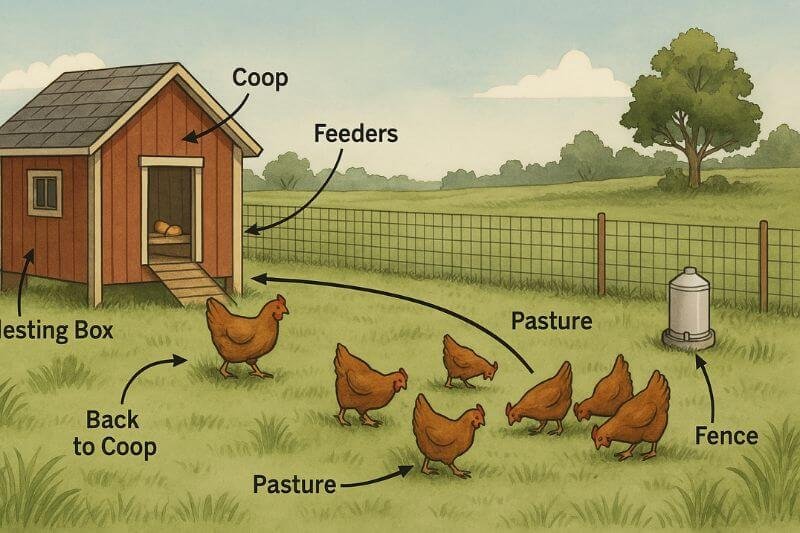
🦊 Common threats:
- Foxes
- Raccoons
- Weasels
- Hawks
- Snakes
- Feral dogs
🛡️ No-power protection:
- Bury hardware cloth 12” underground (stops digging)
- Use tight latches (raccoons open simple ones!)
- Close coop at dusk manually
- Surround run with motion-sensitive noisemakers (wind chimes, bottles)
- Install goose or dog as a guardian animal
- Hang fishing line or CD discs above to deter aerial attacks
“If your coop can’t survive 3 raccoons, a hawk, and a hungry fox, it’s not off-grid-ready yet.” — Homestead Defense Logbook, 2022
🧑🌾 Real Off-Grid Example: Tiny Farmstead in Idaho
Jason and Willa, homesteading in the Idaho backwoods with 12 chickens, produce:
- 50+ eggs/week
- 1 meat bird/month
- Enough compost to fertilize 6 garden beds
- No purchased feed — 100% scraps and free-range
💬 “We haven’t bought eggs or fertilizer in 3 years. Our chickens feed us, clean the garden, and run on scraps. It’s not farming — it’s freedom.”
🐣 Part 3: Long-Term Sustainability and Breeding Off the Grid
🥚 Breeding Your Own Flock: Total Independence
If you rely on buying new chicks each spring, you’re not truly off-grid. The next step in poultry resilience is learning to hatch and raise your own birds.
✅ Natural Breeding Cycle:
- Keep 1 rooster for every 8–10 hens
- Select hens with good laying history and strong health
- Let a broody hen sit on 8–12 eggs in spring
- She’ll incubate them for 21 days, then raise them for 6–8 weeks
“A hen that goes broody and raises chicks is worth more than an incubator when the grid fails.” — Poultry Breeding for Preppers
🔥 Off-Grid Incubation Without Electricity
If you don’t have broody hens, you can still hatch eggs manually — no electricity required.
💡 Off-grid incubation methods:
- Solar-heated box incubator (glass-topped wooden box, thermal mass inside)
- Rocket mass heater rooms (keep ambient temps stable)
- Use hot water bottles + insulation + daily turning
Maintain:
- 99°F (37.5°C) average temperature
- 40–60% humidity (ventilated)
- Turn eggs 3–5 times daily for even development
🛑 Requires precision and attention — but it’s 100% possible off-grid.
🍗 Eggs vs Meat: What’s the Right Balance?
Your flock should reflect your caloric goals, space, and protein needs.
| Objective | Flock Profile |
|---|---|
| Eggs only | 5–8 hens, no rooster |
| Meat only | Raise 20–30 meat chicks every 2–3 months |
| Eggs + meat | Dual-purpose breeds, small rotation batch |
| Barter/backup | Extra hens + separate rooster pen |
💬 Eggs = daily nutrition
💬 Meat = backup calories and feast value
Chickens are more efficient than rabbits or goats in terms of feed-to-protein ratio, especially off-grid.
🌍 Waste Loop: Chickens Close the Nutrient Cycle
Chickens are the perfect element in a closed-loop survival system.
- Feed scraps → chickens
- Chickens produce → eggs, meat, manure
- Manure feeds → garden
- Garden feeds → your family & chickens
No waste. No dependency. Just biological resilience.
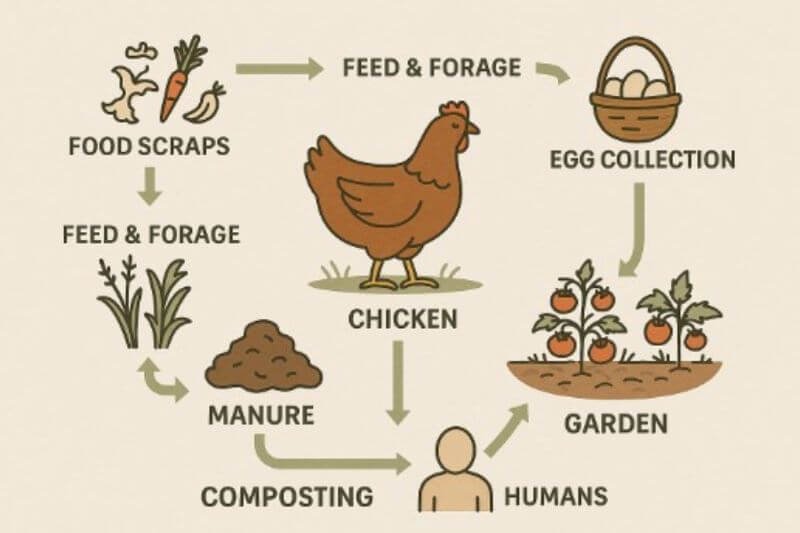
❓ Frequently Asked Questions (FAQ) – Off-Grid Chicken Farming
Q: How long do off-grid chickens live?
Laying hens typically live between 4 to 8 years, depending on breed, environment, and predator exposure. However, their peak egg-laying years are the first 2 to 3, with a noticeable drop in productivity afterward.
Off-gridders generally follow one of two strategies :
- Culling and rotating: Older hens are processed for meat (stew birds) once their egg production drops.
- Brooding and mentoring: Elder hens become natural incubators or chick-raisers, if they go broody and still have strong maternal behavior.
“A hen past her peak may not lay eggs, but she can still teach survival by hatching the next generation.”
Maintaining a rotating flock — with new chicks each season — ensures continuous food output without overwhelming resources.
Q: Can chickens survive winter without heat?
Yes — and in fact, they should.
Chickens are surprisingly resilient in cold weather, especially cold-hardy breeds like Australorp, Orpington, or Plymouth Rock. The key is to keep them dry, out of drafts, and well-ventilated — not warm.
❄️ Winter survival checklist:
- ✅ Draft-free coop: No wind or direct air hitting the birds
- ✅ Deep litter method: Let bedding build up into composting layers that generate heat naturally
- ✅ Ventilation high up: Prevents moisture buildup without chilling the birds
- ✅ Proper breeds: Avoid delicate or tropical breeds
🛑 Avoid heat lamps. They’re fire hazards, disrupt natural acclimatization, and create dependence on grid power — the opposite of what you want.
“A cold bird survives. A wet bird dies.”
Q: How do I protect my chickens when I’m away from home?
In off-grid setups, you become the entire security and care system. But you can still build resilience into your flock care when you’re away for 1–3 days (or more).
🛡️ Short-term protection plan:
- Manual or timed coop locks: Use spring-latch closers or low-tech pulley systems to close doors at dusk
- Multiple waterers and feeders: Redundancy ensures access if one system tips over or freezes
- Gravity-fed buckets: Ideal for feed and water over multiple days
- Natural deterrents: Dogs, geese, or decoy predators (like motion owls)
- Community check-ins: Build trust with a neighbor who can visually inspect and refill as needed
✅ Bonus tip: Install solar LED lights or motion noise-makers to deter night-time predators without electricity.
Q: Is off-grid chicken farming noisy or smelly?
It depends entirely on your management, not the chickens.
🧼 Odor control:
- Dry bedding = no ammonia
- Deep litter system = compost instead of stink
- Regular coop cleanouts = flies stay away
Most bad smells come from moisture + neglect — not the birds.
🔇 Noise control:
- No rooster = no dawn crowing
- Hens cluck quietly, especially if they’re calm, well-fed, and have space
- If you free-range or rotate pens, chickens will be too busy to bicker or squawk
“A clean, dry, and properly spaced flock doesn’t stink — it feeds you and fertilizes your future.”
✅ Conclusion: Chickens Are Your Survival Allies
Off-grid chicken farming isn’t just about food — it’s about systems thinking. These birds turn scraps into protein, fertilize your land, entertain your kids, and give you barter value in times of collapse.
They require little and give back daily. They’re alert, adaptable, and built for survival.
Start with a few. Build from there. And let your chickens teach you how to live off the land — one egg at a time.









